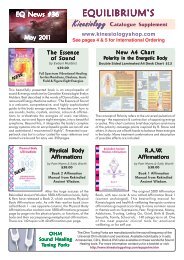You also want an ePaper? Increase the reach of your titles
YUMPU automatically turns print PDFs into web optimized ePapers that Google loves.
Commonly found on mattresses and carpets and in cellars/basements. Produces mycotoxin sterigmatocystin.<br />
Prevalent in over 5% of fungal infections of toenail, particularly involving big toe.<br />
FU3 69 Bipolaris<br />
Linked to allergic and chronic sinusitis and chest infections. Produces mycotoxins cytochalasin, sterigmatocystin<br />
and sporidesmin.<br />
FU3 70 Blastomyces Dermatitidis<br />
Found primarily in the Mid-West and Northern United States and Canada. Causes blastomycosis (lung<br />
infection, chest pains, coughs, fever, painless sores). Produces mycotoxins cytochalasin, sporidfesmin and<br />
sterigmatocystin.<br />
FU3 71 Coccidiodes Immitis<br />
Most commonly seen in the desert regions of the southwestern United States, and in Central and South<br />
America. It can cause a disease called coccidioidomycosis (Valley Fever).<br />
FU3 72 Cryptococcus Neoformans<br />
Found in soil throughout the world. Can cause lung infections (cryptococcosis).<br />
FU3 73 Cylindrocarpon<br />
Found in wet indoor environments. Produces mycotoxin trichothecene.<br />
FU3 74 Memnoniella<br />
Found in soil and plant debris but also inside buildings, especially on cellulose-based materials. Often found<br />
growing with Stachybotrys, but smaller so enters lungs more easily. Most typical symptoms are throat irritation,<br />
eye and nose itchiness and rashes. Produces mycotoxins trichothecenes.<br />
FU3 75 Myrothecium<br />
Often found on materials such as paper, textiles, canvas and cotton. Produces mycotoxin trichothecene.<br />
FU3 76 Penicillium Aurantiogriseum<br />
Commonly found on mattresses and carpets. Produces mycotoxin Penicillic acid.<br />
FU3 77 Penicillium Chrysogenum<br />
Commonly found on mattresses and carpets.<br />
FU3 78 Penicillium Nordicum<br />
Commonly isolated from fermented meat products such as cured ham and dairy products. Produces mycotoxin<br />
ochratoxin A.<br />
FU3 79 Penicillium Verrucosum<br />
Found on cereals (e.g. wheat, barley). Produces mycotoxin citrinin and ochratoxin A.<br />
FU3 80 Pithomyces<br />
Often found growing in soil, decaying leaves and grasses. Produces mycotoxin sporidesmin.<br />
FU3 81 Rhizopus<br />
Found on mature fruits and vegetables, jellies, syrups, bread, peanuts, leather and tobacco. Produces mycotoxin<br />
rhizonin.<br />
FU3 82 Sporothrix Schenkii<br />
Found throughout the world in soil, plants, and decaying vegetation. Skin lesions characteristically following<br />
lymphatic pathways.<br />
FU3 83 Stachybotrys Chartarum /Stachybotrys Atra, Stachybotrys Alternans Or Stilbospora Chartarum<br />
Also known as black mould. Commonly found on wallpapers. Also on paper, cardboard, wallboard, wall framing<br />
when persistently wet. Linked to sick building syndrome. Produces mycotoxins roridin E, satratoxin G & H<br />
and trichothecene.<br />
FU3 84 Wallemia<br />
Found worldwide, and typically contaminate low-moisture foods, carpets and mattresses. Produces mycotoxin<br />
walleminol.<br />
Page 70 Copyright Jane Thurnell Read 2012 Testing Kit Description Manual



